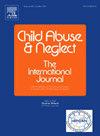不良童年经历与成人精神病理:一种潜在类分析方法
IF 3.4
2区 心理学
Q1 FAMILY STUDIES
引用次数: 0
摘要
不良的童年经历(ace)与不良的心理健康结果有关,但现有的许多研究都侧重于累积风险,而不是不同类型逆境的影响。这限制了对ACE具体模式如何影响精神病理学的深入研究。此外,对ACE暴露与心理健康之间联系的调查通常集中在单一症状类别上,而忽略了共同发生的精神病理。目的:在寻求治疗的成人样本中,我们使用潜在类分析(LCA)来识别ACE暴露的不同模式,并研究其与焦虑、抑郁、创伤后应激障碍(PTSD)和注意力缺陷/多动障碍(ADHD)的关系。参与者和背景参与者为514名寻求心理治疗的18-85岁成年人(71%为女性)(M = 26.25, SD = 8.68)。数据是在一家公共心理诊所使用自我报告方法收集的。方法slca将ACE暴露分为三类:低逆境、虐待(情绪/身体虐待和忽视)和家庭功能障碍(父母精神疾病、分离)。使用DASS-21、PCL-5和ASRS评估精神病理症状。采用Bolck-Croon-Hagenaars (BCH)三步法分析ACE类别与精神病理之间的关系。结果虐待组抑郁和创伤后应激障碍症状明显高于低逆境组。家庭功能障碍组与受虐待组和低逆境组相比均表现出较高的ADHD症状。在控制协变量后,未观察到焦虑的显著差异。结论不同的ACE模式与特定的精神病理症状有关。研究结果强调了将以人为本的方法纳入分析儿童逆境的重要性,这可以为有针对性的预防和治疗策略提供信息。本文章由计算机程序翻译,如有差异,请以英文原文为准。
Adverse childhood experiences and adult psychopathology: A latent class analysis approach
Background
Adverse childhood experiences (ACEs) are linked to poor mental health outcomes, yet much of the existing research focuses on cumulative risk rather than the impact of distinct types of adversity. This limits insights into how specific ACE patterns influence psychopathology. Additionally, inquiries into links between ACE exposure and mental health typically focus on a single symptom class, overlooking co-occurring psychopathologies.
Objective
We used latent class analysis (LCA) to identify distinct patterns of ACE exposure and examine associations with anxiety, depression, post-traumatic stress disorder (PTSD), and attention-deficit/hyperactivity disorder (ADHD) in a treatment-seeking adult sample.
Participants and setting
Participants were 514 adults (71 % female) aged 18–85 (M = 26.25, SD = 8.68) seeking psychological treatment. Data were collected at a public psychology clinic using self-report measures.
Methods
LCA identified three classes of ACE exposure: low adversity, maltreatment (emotional/physical abuse and neglect), and household dysfunction (parental mental illness, separation). Psychopathology symptoms were assessed using the DASS-21, PCL-5, and ASRS. Associations between ACE classes and psychopathologies were analyzed using the Bolck-Croon-Hagenaars (BCH) three-step approach.
Results
The maltreatment class showed significantly higher depression and PTSD symptoms than the low adversity class. The household dysfunction class exhibited elevated ADHD symptoms compared to both maltreatment and low adversity classes. No significant differences in anxiety were observed after controlling for covariates.
Conclusions
Distinct ACE patterns were linked to specific psychopathology symptoms. Findings highlight the importance of incorporating person-centered approaches to analyzing childhood adversity, which can inform targeted prevention and treatment strategies.
求助全文
通过发布文献求助,成功后即可免费获取论文全文。
去求助
来源期刊

Child Abuse & Neglect
Multiple-
CiteScore
7.40
自引率
10.40%
发文量
397
期刊介绍:
Official Publication of the International Society for Prevention of Child Abuse and Neglect. Child Abuse & Neglect The International Journal, provides an international, multidisciplinary forum on all aspects of child abuse and neglect, with special emphasis on prevention and treatment; the scope extends further to all those aspects of life which either favor or hinder child development. While contributions will primarily be from the fields of psychology, psychiatry, social work, medicine, nursing, law enforcement, legislature, education, and anthropology, the Journal encourages the concerned lay individual and child-oriented advocate organizations to contribute.
 求助内容:
求助内容: 应助结果提醒方式:
应助结果提醒方式:


